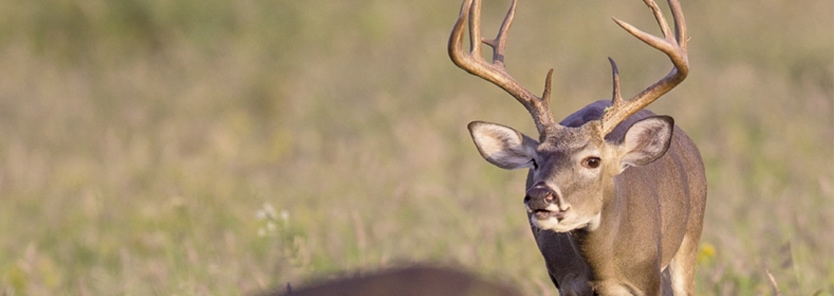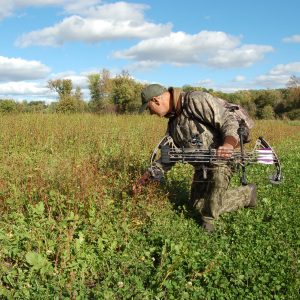Factors in Deer Movement
What Makes Deer Move? Back in the 90s I was involved in a semi-scientific study we called the W.M.W.M. Study (What Makes Whitetails Move).The results of the study were to be fodder for another book, but those involved all had a more jealous motive…we wanted to know under what conditions proved to give us the best potential for seeing more deer and harvesting mature bucks. While any day has the potential for yielding a successful hunt and you have a chance whenever you’re in the field, I wanted to maximize my time. I say it was a “semi-scientific” study because none of us were actually scientists, but we tried to keep it as systematic and precise as possible.
There were five of us scattered throughout Minnesota and Wisconsin who documented statistics such as temperature, wind direction and speed, lunar phase, moon position, cloud cover, precipitation, relative humidity and barometer. We took these readings when we began our observations and then again when we finished in case there were any significant changes. We recorded how many whitetails we saw, what activity they were engaged in (feeding, chasing, simply traveling, breeding, etc.), when it happened and how long it lasted. We also had two unmolested, private, captive “control herds” that could be witnessed at any time to give us something to weigh against our “wild findings.” We hoped that we would find the “mysterious” combination of factors that would give us an edge in the treestand.
Understand, this was before trail cameras and smart phones; we wrote our notes down on paper in pencil. We collected data for seven years, however, I have continued on gathering this information for my own benefit and since the onslaught of all our new technology it’s so much easier. Now-days it’s definitely effortless to gather data and record it, but the findings are the same.
What Makes Deer Move? Moon Phase
One of the main reasons we began this undertaking is because at the time several people were selling “moon gauges,” meaning different charts or gizmos that would predict deer movement by the position or phase of the moon. The reason we began our own study is because our “moon dials” didn’t work – they seemed to be a scam! The one that did show some positive results and matched up with what we saw was Dr. Grant Woods’ Moon Peak Activity Index (at least I think that’s what it was called).
From what I’ve found there is possibly a connection between deer activity and the moon, but any correlation is related more to the position of the moon, how close the moon is to the earth and the moon’s elliptical orbit; better yet, an amalgamation of these factors. It had more to do with the gravitational pull when the moon is closest to the earth than any lunar phase.
I once had a very enlightening conversation with Dr. Woods about this (all conversations with Grant Woods seem to be enlightening) and he said, “You’re onto something!” This made me feel wonderful! Then he said, “However, it will cost you several hundred thousand dollars to buy data from NASA to confirm your findings.” This brought me back to earth.
While we saw no significant divulgence one way or another with the moon phase or position, the amount of light the moon gave off during the night seemed to have a slight impact on movement the following day, but this obviously also had something to do with the cloud cover during the night before. For example, you could have a full moon, but heavy cloud cover and it would still appear very dark.
What Makes Deer Move? Temperature
Temperature also had an influence on movement – whitetails without doubt have a “comfort range.” If it’s too warm after they are sporting their more efficient winter coats, they tend to move much less during daylight hours. And while I’ve killed a couple whopper bucks during blistering cold days (below zero), anything below about 10° to 15° F and movement starts to decline.
Precipitation, wind speed and other secondary conditions also have an influence on deer movement. If it’s raining heavy, where do you want to be? Whitetails will also seek out cover in a deluge. It’s the same with wind speed – deer will typically search out shelter from the gale. Both of these factors, when in play, should only take a little common sense to figure out.
What Makes Deer Move? Barrometric Pressure
In my view, no other aspect of the weather has as big an influence on deer movement as the atmospheric pressure, also known as the barometric pressure. Whitetails have the ability to sense these changes. A barometer is the instrument we measure this with and it refers to the amount of air pressure exerted by air molecules against the earth’s surface. It’s the increase, decrease or stabilization of this pressure that affects deer behavior, sometimes greatly.
Many of you may have witnessed this escalation or decline in deer movement and not known why it was happening. We’ve all had days, even a week or more when you have to admit, it was tough and deer sightings were rare. If you hunt long enough you’ll definitely experience a lull. Then all of a sudden deer appear as if God opened up the “drain plug” on a sink full of whitetails and there are deer everywhere! Unfortunately, just as abruptly, they can mysteriously vanish again.
It’s not hocus-pocus; it’s atmospheric air density that triggers this activity. More to the point, it’s the rapidly rising or falling barometric pressure that precedes or follows a weather front that seems to show the biggest impact. Anytime the barometer is moving is a time you want to be in the woods. You may have heard your weather person mention the terms “low-pressure” or “high-pressure.” This terminology simply refers to increased or decreased barometric pressure within a weather system. If the air molecules above the earth’s surface are not as dense, the result will be a decrease in barometric pressure. The resulting low-pressure system is known to usher in clouds, rain and/or snow. High pressure on the other hand, tends to be clear or very few clouds, low humidity and fair weather.
A whitetails’ inner ear works very much the same way a barometer works. In fact, it’s said that ancient man also had the ability to better sense these changes. Our modern problem being, if you’re watching your barometer at home…you’re too late. Instead, you must anticipate the movement by predicting when weather fronts will arrive and leave your hunting area. On the leading edge and tail edge of the front the barometer will fall or rise – that’s when you want to “be in the tree.”
A high, stable barometer is also good hunting. After compiling our results, whitetails seem to move best when the pressure is between 29.90 and 30.30 inches with the best movement occurring at the higher end of that range, around 30.10 to 30.30 inches. I’ve also seen this with mule deer and pronghorn and it’s likely true with many other animals.
A lot of the “high pressure” fronts will come with wind. Numerous trophies are shot immediately after sustained high winds have died down. We mentioned wind before –I’m not sure, are the whitetails just avoiding the “nor’easter” or sensing the barometric change, probably both.
I read another study in which deer sightings increased dramatically at barometric pressures between 29.80 and 30.28. However the greatest activity was seen with rapid pressure drops of 4 to 5 tenths of an inch. This matches up almost exactly with our deduction.
Conclusion
Keep in mind you must also have other factors in your favor, or more so your deer herd’s favor, if you wish to see the barometric pressure’s influence. If the temperature is outside their comfort range or hunting pressure keeps them bedded, the impact won’t be as significant. Molested whitetails aren’t going to want to move during legal hunting light no matter what the barometer tells you.
Whitetails (and other animals) being able to sense the change in barometric pressure is likely Mother Nature’s way of protecting the herd. The pressure’s change tells the animals they may have to bed down for a period so they better “put on the feed bag” before the coming weather front arrives.
In my opinion, the biggest impression can be seen in the north just before and just after a major snow storm or blizzard. If you can’t predict when this will happen before the front hits, make certain to be in your treestand when the storm breaks – activity is all but guaranteed.
Remember that barometric pressure is only one contributing factor to deer movement. In my view, it is one of the most important elements and should not be overlooked. However, it’s really a combination of factors that all contribute to deer movement. Keep an eye on the barometer, but don’t use it as your only way to predict your herd’s activity.
~
For more from GameKeeper Farming For Wildlife like What Pressure Makes Deer Move? , join our weekly newsletter. Your source for information, equipment, know-how, deals and discounts to help you get the most from every hard-earned moment in the field.






